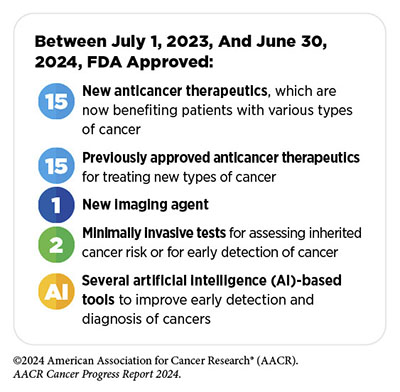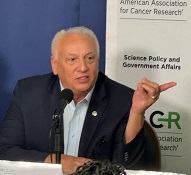AACR Cancer Progress Report Reveals Breakthroughs and Barriers
While strides have been made, there’s still a long way to go. That’s the key takeaway from the American Association for Cancer Research (AACR) 14th annual Cancer Progress Report. The report highlights recent cancer research and treatment breakthroughs while sharing ongoing challenges.
 Over the last year, the U.S. Food and Drug Administration (FDA) approved 15 new cancer treatments, including lifileucel, an innovative therapy that uses tumor-infiltrating lymphocytes to target melanoma. This groundbreaking treatment, developed with the help of clinical trials at Moffitt Cancer Center, represents a significant advance in immunotherapy. Additionally, the FDA expanded the use of 15 previously approved treatments to cover more cancer types. New diagnostic tools, including AI-based technologies for early detection, also received approval.
Over the last year, the U.S. Food and Drug Administration (FDA) approved 15 new cancer treatments, including lifileucel, an innovative therapy that uses tumor-infiltrating lymphocytes to target melanoma. This groundbreaking treatment, developed with the help of clinical trials at Moffitt Cancer Center, represents a significant advance in immunotherapy. Additionally, the FDA expanded the use of 15 previously approved treatments to cover more cancer types. New diagnostic tools, including AI-based technologies for early detection, also received approval.
Decline in Cancer Death Rates
Thanks to these advances, the U.S. saw a 33% reduction in overall cancer deaths between 1991 and 2021. Lung cancer, which once had the highest mortality rate among cancers, experienced one of the most significant declines. The report pointed to earlier detection through screening and the use of targeted therapies and immunotherapies as key factors in reducing lung cancer deaths. Breast and colorectal cancers also saw improvements in survival rates.
Despite these advancements, cancer remains a significant public health issue in the U.S. The report projected that more than 2 million new cancer cases will be diagnosed in 2024, with survival rates varying significantly across cancer types. Despite overall improvements, some cancers, such as pancreatic and liver cancer, continue to have poor outcomes compared to other common cancers.
The report also highlighted that 40% of cancers are linked to preventable factors such as smoking, alcohol use and UV exposure. This finding reinforces the need for strong public health efforts in cancer prevention.

Increasing Cancer Survivorship
As cancer treatments have improved, the number of people living longer after a cancer diagnosis has steadily risen. According to the most recent figures from 2022, more than 18 million Americans have survived cancer. That figure is expected to reach 26 million by 2040. Much of this progress is linked to advancements in precision medicine.

John Cleveland, PhD
“The day is coming when every patient will be holistically evaluated, and their therapy will be personalized to make sure that they have the best possible response for their type of cancer, leading to the best possible outcomes,” said Moffitt Center Director and Chief Scientific Officer John Cleveland, PhD, who spoke at a news conference announcing the report findings.
However, the report acknowledged that surviving cancer also brings its challenges. Many survivors continue to experience long term physical and emotional challenges due to treatment side effects or concerns about cancer recurrence. In addition, many cancer patients face significant financial difficulties, with over 40% depleting their life savings within two years of diagnosis due to the high costs of treatment.
Persistent Disparities in Cancer Care
The report highlighted ongoing disparities in cancer outcomes, particularly among racial and ethnic minorities and underserved populations. While overall cancer incidence rates have stabilized, certain cancers — such as pancreatic cancer and HPV-related oral cancers — are increasing in communities of color and low income areas. Early onset colorectal cancer, which affects adults under 50, is also on the rise.
Multiple factors, including unequal access to healthcare, socioeconomic barriers and structural inequalities within the health care system, drove the disparities in cancer outcomes. The report emphasized the need for targeted public health interventions and policy changes to address these inequities and ensure that advances in cancer care benefit all patients.
Basic Research: A Key to Progress
Decades of basic science research have led to key discoveries about cancer biology. Understanding the common traits of cancers, such as their ability to evade the immune system and spread to other parts of the body, has laid the groundwork for targeted therapies and immunotherapies, which attack cancer cells while minimizing damage to healthy tissue.
"One of the most significant discoveries of the past decade is the realization that our immune system, long known to defend against bacteria and viruses, also plays a crucial role in protecting us from cancer. This insight has led to the development of immunotherapeutics — antibodies that target proteins expressed by tumors to prevent them from suppressing immune cells. These treatments are now widely available and have revolutionized cancer therapy," Cleveland said.
The report stressed that continued investment in basic research is essential to developing future cancer therapies. Many of today’s breakthrough treatments, such as immune checkpoint inhibitors, would not exist without the foundational knowledge gained through basic science. AACR called on Congress to increase funding for the National Institutes of Health, the National Cancer Institute and other federal agencies that support cancer research, stating that without sustained funding, the progress achieved over the past few decades could stall, putting millions of lives at risk.



